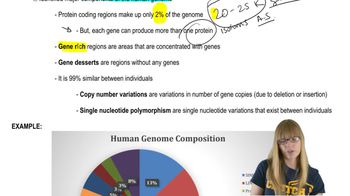Describe three major goals of the Human Genome Project.
Table of contents
- 1. Introduction to Genetics51m
- 2. Mendel's Laws of Inheritance3h 37m
- 3. Extensions to Mendelian Inheritance2h 41m
- 4. Genetic Mapping and Linkage2h 28m
- 5. Genetics of Bacteria and Viruses1h 21m
- 6. Chromosomal Variation1h 48m
- 7. DNA and Chromosome Structure56m
- 8. DNA Replication1h 10m
- 9. Mitosis and Meiosis1h 34m
- 10. Transcription1h 0m
- 11. Translation58m
- 12. Gene Regulation in Prokaryotes1h 19m
- 13. Gene Regulation in Eukaryotes44m
- 14. Genetic Control of Development44m
- 15. Genomes and Genomics1h 50m
- 16. Transposable Elements47m
- 17. Mutation, Repair, and Recombination1h 6m
- 18. Molecular Genetic Tools19m
- 19. Cancer Genetics29m
- 20. Quantitative Genetics1h 26m
- 21. Population Genetics50m
- 22. Evolutionary Genetics29m
15. Genomes and Genomics
Genomics and Human Medicine
Problem 12
Textbook Question
The Human Genome Project has demonstrated that in humans of all races and nationalities approximately 99.9 percent of the genome sequence is the same, yet different individuals can be identified by DNA fingerprinting techniques. What is one primary variation in the human genome that can be used to distinguish different individuals? Briefly explain your answer.
 Verified step by step guidance
Verified step by step guidance1
Understand that although the human genome is about 99.9% identical across all individuals, the small 0.1% variation is what allows us to distinguish between people genetically.
Identify the main type of genetic variation used in DNA fingerprinting: these are called Short Tandem Repeats (STRs) or Variable Number Tandem Repeats (VNTRs), which are sequences of DNA where a short sequence of bases is repeated multiple times in a row.
Explain that the number of repeats at these STR or VNTR loci varies greatly among individuals, making these regions highly polymorphic and useful for identification.
Note that DNA fingerprinting analyzes multiple STR loci across the genome to create a unique genetic profile for each individual, since the combination of repeat numbers at different loci is highly unlikely to be the same in two unrelated people.
Summarize that the primary variation used to distinguish individuals in DNA fingerprinting is the difference in the number of tandem repeats at specific loci in the genome.
 Verified video answer for a similar problem:
Verified video answer for a similar problem:This video solution was recommended by our tutors as helpful for the problem above
Video duration:
1mPlay a video:
Was this helpful?
Key Concepts
Here are the essential concepts you must grasp in order to answer the question correctly.
Human Genome Similarity
The human genome is remarkably similar across all individuals, with about 99.9% of the DNA sequence being identical. This high similarity reflects shared genetic heritage and common biological functions, but the small differences account for individual uniqueness.
Recommended video:
Guided course

Human Genome Composition
Genetic Variation and Polymorphisms
Genetic variation refers to differences in DNA sequences among individuals. Polymorphisms, such as single nucleotide polymorphisms (SNPs) and variable number tandem repeats (VNTRs), are common types of variations that contribute to genetic diversity and can be used to distinguish individuals.
Recommended video:
Guided course

Genomic Variation
DNA Fingerprinting and Short Tandem Repeats (STRs)
DNA fingerprinting uses specific regions of the genome called short tandem repeats (STRs), which are repeating sequences that vary in length between individuals. These variations in STR patterns provide a unique genetic profile for each person, enabling identification despite overall genome similarity.
Recommended video:
Guided course

Genomic Variation

 6:51m
6:51mWatch next
Master Human Genome Composition with a bite sized video explanation from Kylia
Start learningRelated Videos
Related Practice
Textbook Question
808
views
